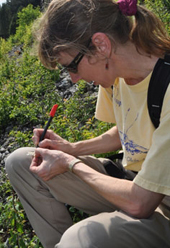AMES, Iowa - Native Iowa prairies that once covered almost the entire area between the Missouri and Mississippi rivers have now shrunk to less than 1 percent of Iowa's landscape.
Restoring some of those prairies, while maintaining Iowa's agricultural productivity, is the goal of ongoing research by Iowa State University researcher Diane Debinski and her colleagues.
Debinski, a professor of ecology, evolution and organismal biology, is working with pasture land in southern Iowa that for many years has been used for grazing.
The research explores techniques for restoring some of the native habitats and the associated birds, butterflies, caterpillars, other insects and plants that go with them.
One of the components - grazing - is very common in Iowa. Another component - burning - has almost vanished in modern times.
 Diane
Debinski
Diane
Debinski
"The project is motivated by trying to return to the natural disturbance processes that the prairie evolved under -- fire and grazing," said Debinski.
Debinski says that prairie fires were a common part of Iowa's land in previous centuries. Whether started by people or by nature, the fires helped get nutrients back into the soil.
Burning also helps reduce the invasion of woody species.
To reintroduce burning in ways that would be best for the soil, the grazing animals and the threatened species, Debinski and her colleagues are testing three different restoration processes using cattle grazing and fire to manage the prairie.
One method involves burning a third of a pasture each year for a three-year period. Over the three years, a different third of the pasture will be burned. Cattle will be allowed to graze on any part of the property. This method is called patch-burn grazing.
The second method involves burning an entire pasture every three years. This method will not involve grazing and is called burn-only.
The third method involves grazing cattle on all areas of a pasture, and burning the entire area at the end of three years. This is called graze and burn.
It is expected that the patch-burn grazing approach will produce more diversity in the vegetation structure compared to the other methods, and that this could be beneficial in promoting biodiversity.
The research is taking place at 13 sites on land owned by the Iowa Department of Natural Resources, as well as land owned by environmental groups and private landowners in Ringgold County in southern Iowa, and counties in northern Missouri.
"The reason we're doing this in southern Iowa is that it is hilly and historically hasn't been used as intensively for crops," said Debinski. "These lands have been used primarily for cattle grazing, so there was less plowing in the past, but the grazing has been intense."
By starting with land that has never been plowed, Debinski thinks the restoration is more likely to be successful.
In all the research pastures, the stocking rate -- the number of cattle per acre -- will be reduced to levels that are more sustainable, leaving more plant cover on the field, said Debinski.
Current grazing practices often leave pastures looking like a golf course, grazed down to the nub, leaving grass one half to one inch tall, according to Debinski.
"There is an expectation that if you use a pasture for grazing, you might as well use all the grass, or you're wasting it," Debinski said of many modern practices.
"We're arguing that leaving more standing vegetation is not necessarily wasting the grass. Leaving something on the ground could provide a buffer in case of drought and it could also help reduce soil erosion associated with heavy precipitation," she said.
"It's not a bad thing to leave some grass on the ground, and this will also provide habitat for other species," said Debinski. "Restoring the prairie will promote biodiversity of other species, including songbirds, pollinators, and a diversity of other insects."
The research has been going on since 2006 and the land has gone through a full, three-year cycle.
At the end of a second cycle, Debinski and her colleagues hope to have a better understanding of how to improve the system.
"The goal is to try to figure out better ways to manage grasslands so we can maintain a working landscape that includes raising cattle, but also promotes higher levels of biodiversity," she said.
Debinski is collaborating with a team including ornithologist
Jim Miller, University of Illinois, Urbana-Champaign; rangeland
ecologist Dave Engle, Oklahoma State University, Stillwater;
sociologist Lois Wright Morton, and project manager Ryan Harr,
both from Iowa State University, along with graduate and
postdoctoral students.